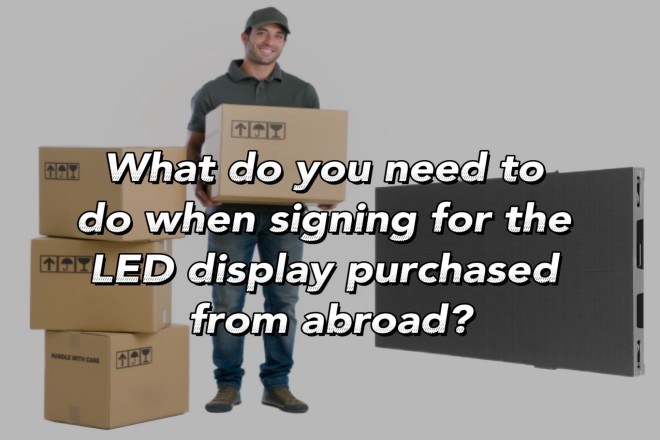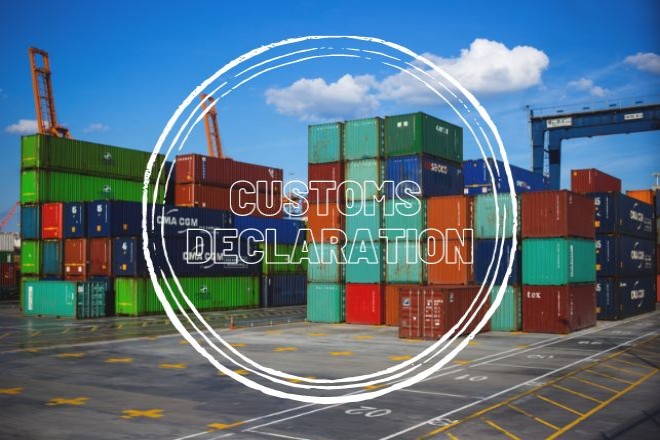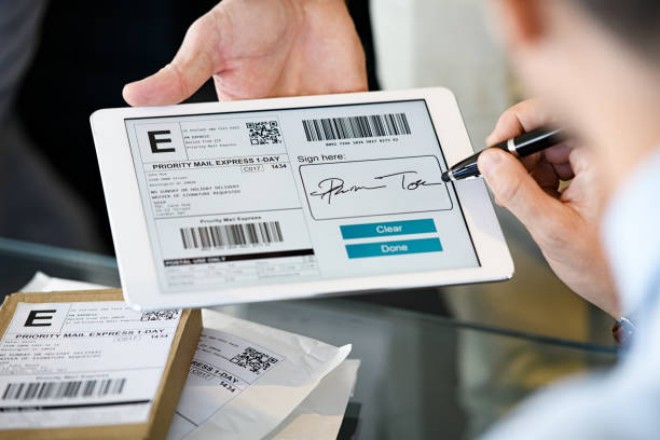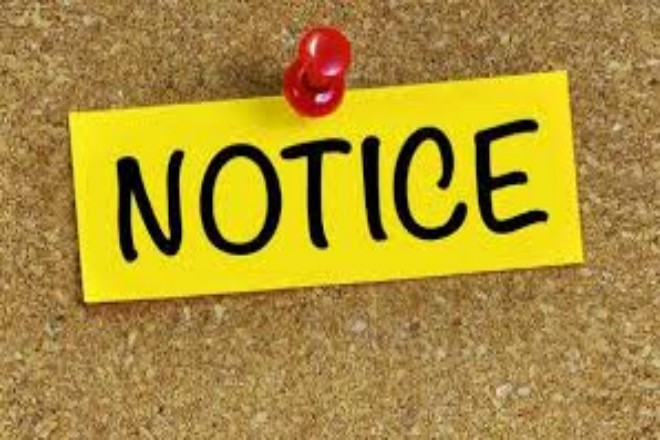مقدمة

في ظل العولمة الحالية، تُستخدم شاشات العرض LED، كأداة مهمة لنشر وعرض المعلومات، عبر الحدود، وتُشكل جسرًا مهمًا يربط بين مختلف البلدان والمناطق. ومع ذلك، فإن التسجيل في شاشات عرض LED الشراء من الخارج ليس بالأمر السهل، إذ يتطلب عمليات استيراد معقدة، ومتطلبات تنظيمية صارمة، وإجراءات توقيع مفصلة.
تهدف هذه المقالة إلى تزويد العملاء الأجانب بدليل توقيع مفصل لمساعدتك في إكمال كل رابط بنجاح من الطلب إلى التوقيع والتأكد من إمكانية وصول شاشة العرض LED بأمان وقانونيًا ووضعها قيد الاستخدام.
1. ما هي الاستعدادات التي يجب القيام بها قبل التوقيع؟
قبل التوقيع على شاشة عرض LED المشتراة من الخارج، لضمان سير الأمور بسلاسة، عليك القيام بسلسلة من الاستعدادات الدقيقة والمدروسة. ستساعدك الخطوات التالية على فهم مختلف الأمور والاستعداد لها بشكل أفضل قبل التوقيع:
1) اختيار الموردين بعناية وتوضيح تفاصيل البضائع
- اختيار الموردين الموثوق بهم:
هذا هو أساس عملية المعاملة بأكملها. عليك استبعاد موردو شاشات العرض LED مع سمعة طيبة وجودة المنتج الموثوقة من خلال أبحاث السوق والتحقق من مؤهلات الموردين ومراجعات العملاء وما إلى ذلك.
- تأكيد مواصفات وكمية البضاعة:
تواصل مع المورد بالتفصيل للتأكد من دقة مواصفات شاشة LED التي طلبتها (مثل الدقة والحجم والسطوع، إلخ)، والطراز، والكمية، وغيرها من المعلومات. يُفضل تسجيل هذه المعلومات كتابيًا كجزء من الطلب.
2) توضيح شروط المعاملة وطرق الدفع
يُنصح هنا باستخدام حساب شركة، فهو أكثر رسميةً وموثوقيةً، ويمثل ضمانًا لك وللمورّد.
بخصوص دفع رسوم الشراء، يُمكنك مناقشة نسبة الدفع مع المورد قبل توقيع العقد. على سبيل المثال، بعد توقيع العقد، ما عليك سوى دفع عربون بقيمة 30%. عند إنتاج شاشات LED وشحنها، يُمكنك إجراء عمليات فحص عبر الإنترنت أو خارجه. بعد اعتماد المنتج، ادفع المبلغ المتبقي وهو 70%.
أخيرًا، عليك أيضًا الاستفسار من المورد بوضوح عن طرق تحصيل الرسوم واختيار طريقة الدفع الأنسب لك. على سبيل المثال، يدعم BIBILED معاملات الجهات الخارجية. بالإضافة إلى التحويلات المصرفية، يمكنك استخدام Alibaba وAlipay.
3) جمع وإعداد الوثائق اللازمة
- بوليصة الشحن:
هذه شهادة تُثبت ملكيتك للبضائع. يمكنك التوقيع عليها، ولكن لا تقلق، سيُسلمك المورد هذه الشهادة بعد شحن البضائع.
- شهادة المنشأ:
هذه وثيقة مهمة تثبت موقع إنتاج شاشة LED، مما يساعد الجمارك على تحديد معدل التعريفة الجمركية.
- قائمة التعبئة والفاتورة:
تتضمن قائمة التعبئة نوع البضاعة وكميتها وتغليفها ومعلومات أخرى مفصلة، بينما تُستخدم الفاتورة لحساب التعريفة الجمركية. يجب تقديم كلا الوثيقتين للتخليص الجمركي.
- خطاب الإقرار الجمركي وخطاب التفتيش:
إذا لم تكن لديك قدرات خاصة في التصريح الجمركي والتفتيش، فأنت بحاجة إلى تكليف وكيل تصريح جمركي محترف أو شركة لوجستية للتعامل مع الأمر نيابة عنك.
في هذا الوقت، يتعين عليك إعداد خطاب إقرار جمركي وخطاب تفتيش لتمنحهم تفويضًا واضحًا لإجراء عمليات الإقرار الجمركي والتفتيش نيابة عنك.
- معلومات ملف المرسل إليه:
بعض الجمارك تشترط على المرسل إليهم تقديم طلب مسبق. عليك التأكد من ضرورة تقديم رقم الطلب وإعداد المعلومات اللازمة.
بعد الانتهاء من هذه الاستعدادات، يمكنك الترحيب بوصول شاشة LED بثقة أكبر.
أثناء عملية التوقيع، تأكد من إبقاء التواصل مع الموردين ووكلاء التصريح الجمركي والأطراف الأخرى مفتوحًا للتأكد من أن جميع الإجراءات والوثائق كاملة ودقيقة.
وفي الوقت نفسه، ينبغي الانتباه جيدًا إلى ديناميكيات البضائع أثناء النقل حتى يمكن التعامل مع المشكلات المحتملة في الوقت المناسب.
2. عملية الإقرار الجمركي لاستيراد شاشات LED

استيراد شاشات LED عملية معقدة ولكنها منظمة، ورابط الإقرار الجمركي بالغ الأهمية. فيما يلي خطوات الإقرار الجمركي لاستيراد شاشات LED بالتفصيل لمساعدتك على فهم العملية وإتمامها بنجاح:
الخطوة 1: اختيار وكيل الإقرار الجمركي وإعداد المستندات
1) اختيار وكيل التصريح الجمركي المحترف:
أنت بحاجة إلى وكيل إقرارات جمركية يتمتع بخبرة واسعة في الإقرارات الجمركية للواردات. يجب أن تكون هذه الشركة قادرة على تقديم مجموعة كاملة من خدمات الإقرارات الجمركية، بما في ذلك إعداد الوثائق، والإقرارات الجمركية، ودفع الضرائب، وغيرها.
2) إعداد الوثائق والمواد اللازمة:
يتعين عليك تقديم سلسلة من المستندات والمواد اللازمة إلى وكيل الإقرار الجمركي، بما في ذلك على سبيل المثال لا الحصر:
شهادة المنشأ: تثبت مكان إنتاج شاشة LED.
قائمة التعبئة: تسرد النوع والكمية والتغليف وغيرها من المعلومات حول البضائع بالتفصيل.
الفاتورة: تستخدم لحساب التعريفات.
العقد: عقد معاملة بينك وبين المورد.
إثبات حقوق الاستيراد والتصدير: إثبات أن المورد لديه مؤهلات الاستيراد والتصدير القانونية.
شهادة 3C أو شهادة إعفاء 3C (إن وجدت): وفقًا للوائح الصينية ذات الصلة، تحتاج بعض المنتجات الإلكترونية المستوردة إلى الحصول على شهادة 3C أو تقديم شهادة إعفاء 3C.
خطاب الإقرار الجمركي وخطاب التفتيش: تفويض وكيل الإقرار الجمركي للقيام بعمليات الإقرار الجمركي والتفتيش نيابة عنك.
معلومات تسجيل المستلم (إذا لزم الأمر): تتطلب بعض الجمارك من المستلمين التسجيل مسبقًا.
معلومات المنتج: بما في ذلك المعلومات التفصيلية مثل اسم المنتج والكمية والتغليف والوزن والحجم وما إلى ذلك.
الخطوة 2: انتظار وصول البضاعة والتعامل مع بوليصة الشحن
- تلقي إشعار وصول البضاعة:
عند وصول البضائع إلى الميناء أو المطار المحلي عن طريق البحر أو الجو، سوف تتلقى إشعارًا بوصول البضائع صادرًا عن شركة الشحن أو شركة الطيران.
- التعامل مع إجراءات بوليصة الشحن:
يجب عليك استخدام بوليصة الشحن ومستندات النقل الأخرى لإصدار بوليصة الشحن لدى الوكالة المُحددة من قِبل شركة الشحن أو شركة الطيران. بعد تعديل بوليصة الشحن، ستحصل على بوليصة شحن أو بوليصة شحن، وهي شهادة ضرورية لاستلام البضاعة لاحقًا.
الخطوة 3: التفتيش والإقرار الجمركي
- تقديم نموذج إقرار الجمارك للاستيراد:
وفقًا لمتطلبات الجمارك، يتعين عليك ملء نموذج إقرار الجمارك للاستيراد وإرساله.
يجب أن يتضمن نموذج الإعلان بالتفصيل اسم البضائع وكميتها وسعرها ومنشأها وغيرها من المعلومات المتعلقة بها، ويجب أن يكون متوافقًا مع المستندات والمعلومات المقدمة.
- التعاون مع الجمارك للإعلان عن الأسعار وتفتيش البضائع:
خلال عملية الإقرار الجمركي، يُرجى التعاون مع الجمارك لإعلان الأسعار. يُرجى التأكد من أن السعر الذي تُقدمه صحيح ومعقول لتجنب أي مشاكل لاحقاً.
وفي الوقت نفسه، وفقًا لتعليمات التفتيش الجمركي، قد تحتاج إلى التعاون مع فحص البضائع.
أثناء التفتيش، يقوم موظفو الجمارك بالتحقق مما إذا كانت الكمية والجودة والمواصفات وما إلى ذلك للبضائع متوافقة مع الإعلان.
الخطوة 4: دفع الضرائب والحصول على شهادات دفع الضرائب
- حساب الضرائب:
وفقًا للوائح فئة البضائع وسعرها ومعدل الضريبة الجمركية عليها، يُرجى حساب التعريفات الجمركية وضرائب الاستيراد المستحقة. يُمكنكم الاستعلام والحساب عبر الموقع الإلكتروني الرسمي للجمارك أو منصة وكيل الإقرار الجمركي الإلكترونية.
- دفع الضرائب:
وفقًا لمتطلبات الجمارك، يتعين عليك دفع التعريفات والضرائب المتعلقة بالاستيراد من خلال طريقة الدفع المحددة.
بعد دفع الضرائب، تُصدر الجمارك شهادة دفع ضريبية مُناسبة. تُعد هذه الشهادة ضرورية لاستلامك البضاعة وإجراءات أخرى لاحقة.
الخطوة 5: فحص البضائع وإطلاقها واستلامها
- فحص البضائع والموافقة عليها:
تقوم الجمارك بفحص البضائع والموافقة عليها حسب المعلومات الواردة في نموذج الإقرار والوثائق والمواد المقدمة.
يتضمن محتوى التفتيش، ولكن لا يقتصر على، ما إذا كانت الكمية والجودة والمواصفات وما إلى ذلك للسلع متوافقة مع الإعلان.
- اجتياز إجراءات التفتيش والإفراج:
بعد اجتياز البضاعة للفحص والموافقة الجمركية، تُصدر الجمارك إشعار فحص وإفراج، أو أمر إفراج. هذه الشهادة ضرورية لاستلام البضاعة.
- استلام وتسليم البضائع:
مع إشعار التفتيش والإفراج أو أمر الإفراج وبوليصة الشحن أو بوليصة الشحن، يمكنك التوجه إلى مستودع الميناء أو المطار لاستلام البضائع. بعد استلامها، يمكنك ترتيب نقلها إلى موقع محدد داخل الدولة.
أثناء عملية الإقرار الجمركي للاستيراد بأكملها، يرجى التأكد من الحفاظ على التواصل الوثيق مع وكيل الإقرار الجمركي والجمارك والأقسام الأخرى.
في حال واجهتكم أي مشاكل أو استفسارات، يُرجى استشارة وطلب المساعدة في أسرع وقت ممكن. كما يُرجى الانتباه جيدًا لديناميكيات البضائع أثناء النقل والإقرار الجمركي لمعالجة أي مشاكل محتملة في الوقت المناسب.
3. ماذا يجب أن أفعل في رابط التوقيع والاستلام؟

يعد التوقيع على شاشة LED المستوردة من الخارج رابطًا رئيسيًا، يشير إلى أن البضائع قد أكملت عملية الاستيراد رسميًا وتم تسليمها إليك.
وفيما يلي الخطوات التفصيلية لعملية التوقيع، والتي تم تصميمها لمساعدتك على إكمال عملية التوقيع بسلاسة:
1) ترتيب نقل البضائع
- تحديد وسيلة النقل:
اختر وسيلة النقل المناسبة بناءً على الكمية والحجم والوزن ومدة النقل وتكلفة البضائع. يُعد النقل البحري مناسبًا للبضائع السائبة، فهو أقل تكلفةً ويستغرق وقتًا أطول.
النقل الجوي أسرع ولكنه أكثر تكلفة، والنقل البري مناسب لنقل البضائع في البلدان المجاورة.
- اختر شركة تأمين لتأمين البضائع:
لضمان سلامة البضائع، يُنصح باختيار شركة تأمين موثوقة لتأمين البضائع قبل النقل. بهذه الطريقة، في حال تلف البضائع أو فقدانها أثناء النقل، يمكنك الحصول على تعويض مناسب.
بعد بدء نقل البضائع، سيُعطيك مورّدك بوليصة شحن. إذا كان مورّدًا مُلتزمًا، فلن تُقدّم لك بوليصة الشحن فحسب، بل ستُنشر لك أيضًا قائمة فحص وصور ومواد الفحص عبر الإنترنت.
2) وصول البضائع إلى بلد المقصد
- تلقي إشعار وصول البضائع:
عند وصول البضاعة إلى بلد المقصد، ستتلقى إشعار وصول صادرًا عن شركة الشحن أو الجمارك. يُرجى الانتباه إلى وقت وصول البضاعة، ومكان التفريغ، والمستندات المطلوبة في الإشعار.
- إعداد وثائق التوقيع اللازمة:
قبل وصول البضائع، يجب عليك إعداد جميع مستندات التوقيع اللازمة، بما في ذلك على سبيل المثال لا الحصر تراخيص الاستيراد، والإقرارات الجمركية، وشهادات دفع الضرائب، وسندات الشحن، وما إلى ذلك. سيتم استخدام هذه المستندات للتعامل مع إجراءات الاستلام والتوقيع.
3) فحص البضائع واستلامها
- فحص البضائع في شركة الشحن أو المستودع الجمركي:
قبل استلام البضاعة، يحق لك فحصها. يُرجى التواصل مع شركة الشحن أو مستودع الجمارك لترتيب موعد لفحص البضاعة.
أثناء التفتيش، يرجى التحقق بعناية مما إذا كانت الكمية والمواصفات والنماذج ومظهر البضائع سليمة.
- تأكد من أن البضائع غير تالفة وأن المواصفات والنماذج صحيحة:
أثناء عملية التفتيش، إذا وجد أن البضائع تالفة أو أن المواصفات والنماذج لا تتطابق مع الطلب، فيرجى الاتصال بشركة الشحن أو المورد على الفور والاحتفاظ بالأدلة ذات الصلة للمعالجة اللاحقة.
إذا كانت البضاعة سليمة والمواصفات والنماذج صحيحة، فيمكنك الاستمرار في إجراءات الاستلام.
- التوقيع على استلام البضائع والاحتفاظ بالإيصال:
بعد التأكد من صحة البضاعة، يمكنك التوقيع رسميًا على استلامها. يُرجى التأكد من توقيع الإيصال والاحتفاظ بنسخة منه كقسيمة.
الإيصال وثيقة مهمة لإثبات استلامك للبضائع. في حال وجود أي نزاعات أو مشاكل لاحقًا، سيكون دليلًا هامًا.
خلال عملية الاستلام، يُرجى الحرص على التواصل المستمر مع شركة الشحن والجمارك والموردين. في حال واجهت أي مشاكل أو استفسارات، يُرجى استشارة وطلب المساعدة في الوقت المناسب.
وفي الوقت نفسه، من الضروري أيضًا التأكد من أن جميع المستندات كاملة ودقيقة حتى يمكن التعامل مع إجراءات الاستلام والتوقيع بسلاسة.
4. ماذا ينبغي القيام به بعد ذلك؟
1) التفريغ والتخزين السليم
1.1). خطوات التفريغ التفصيلية:
تعيين فريق محترف: قبل تاريخ وصول البضائع المتوقع، حدد موعدًا مع فريق محترف يتمتع بخبرة تفريغ غنية مسبقًا.
تأكد من فهمهم لخصائص البضائع (مثل الوزن والحجم والهشاشة وما إلى ذلك) وإعداد أدوات ومعدات التفريغ المناسبة.
الإشراف في الموقع: أثناء عملية التفريغ، عيّن شخصًا متخصصًا للإشراف في الموقع. تأكد من أن عملية التفريغ سلسة ومنظمة لتجنب أي تصادم أو سقوط محتمل.
فحص السلامة: بعد التفريغ، يجب إجراء فحص سلامة أولي للبضائع فورًا. تأكد من سلامة العبوة، ومن عدم وجود أي تلف أو تشوه واضح في البضائع.
1.2). احتياطات التخزين:
اختر مستودعًا مناسبًا: اختر مستودعًا جافًا وجيد التهوية ومقاومًا للرطوبة والغبار للتخزين. تجنب استخدام الأدوات الحادة أو الثقيلة داخل المستودع لتجنب خدش شاشة LED أو خدشها.
التوزيع المناسب: رتّب مساحة المستودع بشكل مناسب لحجم ووزن البضائع. تأكد من تكديس البضائع بإحكام لتجنب انقلابها أو انزلاقها.
التفتيش المنتظم: قم بفحص شاشات العرض LED المخزنة بانتظام للتأكد من عدم تأثر البضائع بالعوامل البيئية (مثل الرطوبة والعفن وما إلى ذلك).
2) التثبيت الاحترافي والتصحيح الدقيق
2.1) خطوات التثبيت التفصيلية:
اختر فريقًا محترفًا: اختر فريقًا محترفًا ذا خبرة في تركيب شاشات LED. تأكد من فهمهم لخصائص المنتج ومتطلبات تركيبه.
تجهيز الموقع: قبل التركيب، تأكد من تنظيف موقع التركيب جيدًا وخلوه من أي عوائق. جهّز أدوات ومواد التركيب اللازمة.
التركيب الآمن: أثناء عملية التركيب، التزم بإجراءات السلامة التشغيلية بدقة. تأكد من ارتداء المثبتين معدات السلامة اللازمة لتجنب الحوادث.
2.2). خطوات التصحيح التفصيلية:
توصيل النظام: وفقًا لدليل المنتج، تأكد من توصيل سلك الطاقة، وكابل الإشارة، وما إلى ذلك لشاشة عرض LED بشكل صحيح. تأكد من أن التوصيل متين وثابت.
تصحيح الأخطاء الأولي: شغّل النظام وأجرِ تصحيحًا أوليًا. تحقق من مطابقة تأثيرات العرض، والسطوع، والتباين، وغيرها من معلمات شاشة العرض للمتطلبات.
الضبط الدقيق: بناءً على نتائج التصحيح الأولي، قم بإجراء تعديلات دقيقة. تأكد من أن لون ووضوح شاشة العرض في أفضل حالاتهما.
5. أشياء يجب ملاحظتها

عند استيراد شاشات العرض LED، هناك عدة نقاط رئيسية تحتاج إلى اهتمام خاص لضمان سير العملية بأكملها بسلاسة:
1) يجب أن تكون العبوة آمنة
تذكير الموردين: تأكد من أن تغليف شاشات العرض LED آمن وقوي ويمكنه تحمل الاصطدامات والضغط أثناء النقل لمسافات طويلة.
وضع علامات واضحة: يجب أن تكون هناك علامات واضحة مثل "هش"، "لا تضعه رأسًا على عقب"، "خطر الضغط الشديد" على العبوة الخارجية لتذكير موظفي النقل بالتعامل معها بحذر.
2) شراء التأمين، فقط في حالة
تأمين الشحن: قم بشراء تأمين الشحن لشاشات العرض LED للحصول على تعويض مالي في حالة حدوث ضرر أثناء النقل.
المطالبة في الوقت المناسب: إذا كانت البضائع تالفة بالفعل، فاتصل بشركة التأمين على الفور وقم بتوفير المواد الداعمة اللازمة للمطالبة.
3) الالتزام بالقوانين واللوائح
الإجراءات القانونية: تأكد من أن جميع إجراءات الاستيراد قانونية ومتوافقة، بما في ذلك التقدم بطلب للحصول على تراخيص الاستيراد، والإقرارات الجمركية، ودفع الضرائب، وما إلى ذلك.
فهم اللوائح: قبل الاستيراد، قم بدراسة قوانين الاستيراد ذات الصلة وسياسات الضرائب في بلد المقصد بالتفصيل للتأكد من أن أنشطة الاستيراد تلبي المتطلبات المحلية.
4) نصائح أخرى:
اختر شركة الشحن المناسبة: ابحث عن شركة شحن ذات سمعة طيبة وخبرة لنقل شاشات العرض LED الأكثر موثوقية.
متابعة النقل: التواصل مع شركة الشحن بشكل منتظم لفهم تقدم البضائع والتأكد من وصول البضائع في الوقت المحدد.
حفظ المستندات: يجب حفظ جميع المستندات والملفات التي تم إنشاؤها أثناء عملية الاستيراد بشكل صحيح للاحتياجات اللاحقة.
إن اتباع هذه الاحتياطات يمكن أن يساعدك في استيراد شاشات LED بسلاسة وأمان أكثر.
خاتمة
باختصار، يُعدّ توقيع عقود شاشات LED المشتراة من الخارج عمليةً معقدةً تتطلب روابط متعددة وتعاونًا متعدد الأطراف. من خلال تقديم هذه المقالة، نأمل أن نوفر للعملاء الأجانب دليل توقيع شاملًا وعمليًا لمساعدتهم على فهم مختلف التحديات في عملية الاستيراد والتعامل معها بشكل أفضل.
أثناء عملية التوقيع، تأكد من الحفاظ على التواصل الوثيق مع الموردين ووكلاء الجمارك وشركات الشحن والأطراف الأخرى لضمان دقة المعلومات وتوقيتها.
وفي الوقت نفسه، يجب الانتباه دائمًا إلى لوائح الاستيراد والسياسات الضريبية للبلد المقصد لضمان قانونية وامتثال عملية الاستيراد بأكملها.
أخيرًا، إذا كنت تريد معرفة المزيد عن شاشات LED، يرجى الحصول على اتصال معنا.
